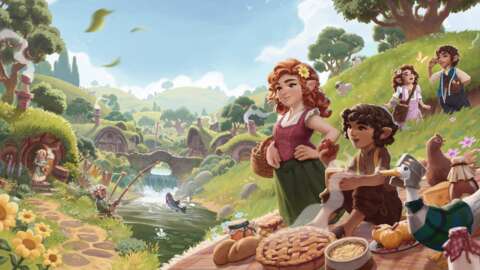The first time I watched Lord of the Rings, I wanted nothing more than to be a gorgeous, willowy, and effortlessly cool elf who was, as nearly all eight year-old girls desired, married to Orlando Bloom’s Legolas. In my late teens, I grew content with remaining human so long as I got the chance to swoon over Aragon. But now, at the wise age of almost-31, I know the truth: The greatest being that you could ever hope to be in Middle-earth is a hobbit. Fortunately, Tales of the Shire lets you do just that.
Wētā Workshop’s Tales of Shire is a cozy life-simulation game that revolves around Tolkien’s coziest creatures, hobbits. Considering the high-demand for wholesome titles and the enduring love for the Lord of the Rings series, I always felt it was simply a matter of time until a game celebrating these jovial and endlessly hungry creatures was developed. After all, what do hobbits do but tend to their land, drink, dance, be merry, and, occasionally, set off on an epic quest to save the world? I recently had the chance to do almost all these things while playing a two hour preview build of Tales of the Shire, but unfortunately, I didn’t walk away from the experience as content as a Gamgee snug in their hobbit-hole. While Tales of the Shire is charming and has some good fundamentals, Wētā Workshop will need to embark on a journey filled with several quality-of-life improvements and a few major overhauls if it wants to make this game something special.
The preview follows your created character leaving their hometown of Bree to start a life of their own in one of The Shire’s quaintest villages, Bywater. When you get there, however, your first series of quests involves proving that Bywater actually is a village, as a local curmudgeon implies the village is more “Backwater” than Bywater.
This storyline serves as a sort of tutorial for the game, as it introduces you to some of your neighbors and the game’s core features: fishing, cooking, gardening, foraging, and nurturing relationships. Many of these features really worked for me. The game’s fishing mechanic, while not novel, is a fun, tension-based mini-game that avoids being annoying or grueling. Despite not being someone especially fond of in-game cooking or crafting–generally I do those things out of necessity–I actually found myself wanting to spend a significant amount of time in my kitchen. Rather than just hitting a few buttons to make a meal, you are encouraged to chop and cook your ingredients to create a more textured dish.
This ties in with gardening and foraging, as high-quality ingredients, spices, and herbs help elevate the meal’s overall flavor. I adored mindlessly wandering through the woods, picking up hops, puffball mushrooms, and currants. Another system I really enjoyed in Tales of the Shire is Companion Crops, which gives certain crops bonuses if they are grown next to a crop it gets along with. Conversely, there are some crops that should be kept in different beds, lest their quality decline. After harvesting, collecting, and fishing up ingredients, it was easy to throw ’em all into my massive pantry that you can seamlessly pull from while cooking. In short, the more “free-form” elements of Tales of the Shire work together splendidly.
However, the “nurturing relationships” aspect is a different story. Though one of the ways you can improve your relationships–inviting your neighbors over for a dinner party that will satiate their cravings–is fun, that is unfortunately about the extent of what I enjoyed. While I liked the game’s writing overall, many of the town’s villagers felt same-y to me, each offering the same cheeky banter and, more gratingly, frustrating fetch quests. So much of my time in the village was spent going back and forth between a select few hobbits, with a particularly egregious quest seeing me going back and forth between the same two hobbits upwards of four times.
And while the overall environment is lovely and evocative of The Shire we know and love–quaint, comforting, and verdant–I found myself continuously irked by the game’s quirks. Bywater is filled with hobbits, a clear effort to make the town feel lived-in that I understand completely. But it quickly grew frustrating when I was trying to walk around and meet my neighbors and just about every hobbit I bumped into was an NPC whom I could not interact with. Despite being filled with people, it began to feel a bit scarce.
In lieu of a traditional mini-map, compass, or some other form of “breadcrumb trail” to follow, Tales of the Shire chooses to immerse players by having them follow blue birds that will perch themselves atop fence posts and signs every so often. While cute in theory, it would often get a bit frustrating when I was going faster than the birds would appear, or when I was traversing through a denser area–such as the town square or woods–and would simply lose track of them. Considering Bywater is so deeply embedded in nature and filled with small bridges, winding roads, and only a couple handfuls of NPCs you can interact with, scattered about the map, not being able to fully rely on the birds was frustrating. Despite the game clearly not wanting you to be constantly pulling up your map and losing that sense of whimsical adventure, I felt like I had to. And these are just a couple of my gripes.
Between the fetch quests, my growing frustrations with certain features, and the lack of compelling characters or plot points, I eventually found myself not particularly interested in leaving my little hobbit-hole. However, unlike a game like Stardew Valley in which being fairly reclusive and focusing on creating your own little slice of paradise is viable, Tales of the Shire seems reliant upon you interacting with your neighbors. Partly because you’d be hard pressed to actually fill your entire day doing all the truly fun things, even if you do decide to spend a chunk of time giving your home a fun little makeover.
This then relegates you to doing quests that are not particularly unengaging for neighbors who are not particularly engaging. It’s also worth pointing out that, at least in the preview, there was no calendar filled with birthdays, festivals, or any other events. This gave me pause, as without something to break up the mundane aspects of the game, I am not sure that I would be compelled to keep playing. Ultimately, that is the biggest issue with Tales of the Shire right now: Even a life sim sicko like me (don’t ask how many hours I’ve put into Moonstone Island and Fields of Mistria this year) doesn’t feel pulled in by this game. Though it has some great features, lovely music, an art style that, while a bit clunky, feels suiting and adds a great deal of charm, and an incredible IP behind it, the whole package offered doesn’t quite work. Fortunately, the game was delayed out of 2024 and will instead be released in early 2025, hopefully giving the team a bit of time to polish the game into something Gollum would covet.



